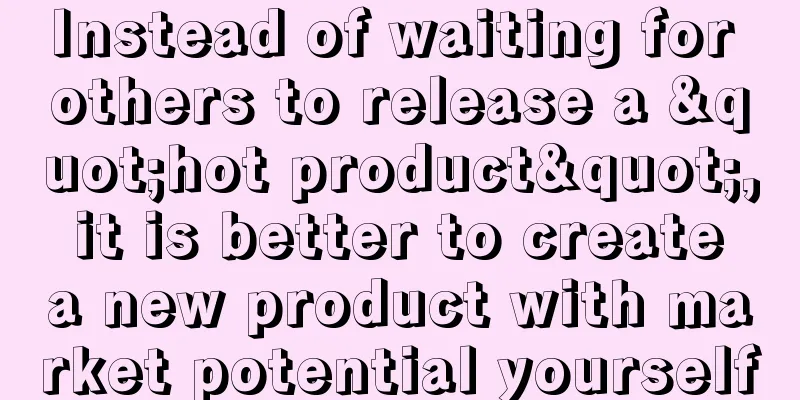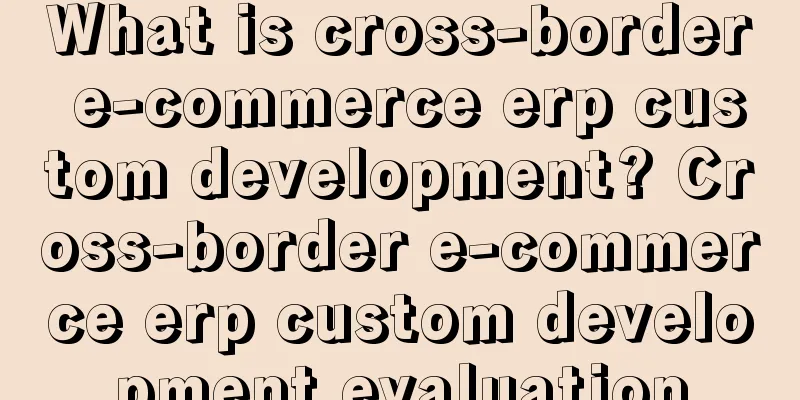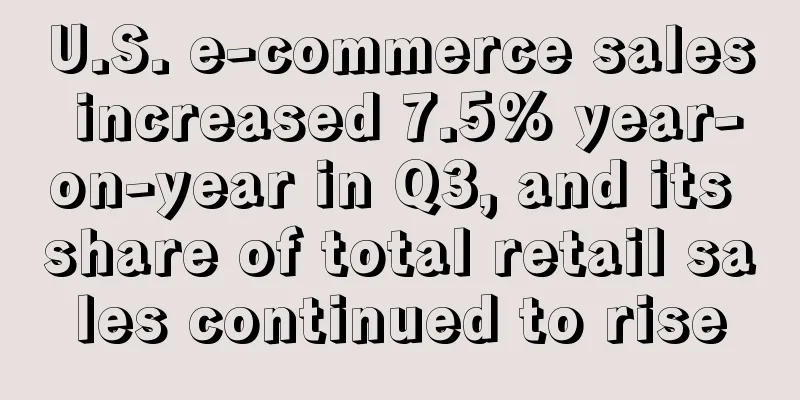Instead of waiting for others to release a "hot product", it is better to create a new product with market potential yourself

|
There are now rich product lines and a wide variety in the market, but some cross-border e-commerce sellers may encounter such a problem: after choosing and choosing, they don’t know what to sell. At this time, some sellers will follow the trend of others to sell "hot items", while others will have the idea of developing new products themselves. For companies that want to develop new products, turning product ideas into reality is often one of the biggest obstacles. The product development process seems elusive, but if you listen to some sellers’ stories, you will find that the road from product idea to finished product is often not smooth. For example, after Tina Roth-Eisenberg pasted rough disposable tattoos on her daughter countless times, she soon realized that there was a lack of exquisite semi-permanent tattoos on the market, so she mobilized professional designers from all over the world to create the Tattly website to sell semi-permanent tattoos. David Barnett had to teach himself how to use 3D design software before he could design the popular mobile phone accessories PopSockets. These inspirational stories, per se, don’t offer a blueprint for product development, but they are similar in that they illustrate some of the steps founders must take on their journey to building a product. New product development is the process of bringing an original product concept to market. Although it varies from product industry to product industry, it can basically be divided into 6 stages: developing ideas, product research, making plans, designing prototypes, sourcing materials and calculating costs. Here are the things sellers should consider at each step: Many entrepreneurs often suffer from a lack of new ideas. They are always waiting for other "geniuses" to appear and create high-quality new hit products, and then they will sell them themselves. Although it is basically possible to create a brand new product, many good ideas are based on the update and iteration of existing products. Sellers can use some tools to view and upgrade existing hot-selling models. If the seller still has no idea, he can use SCAMPER thinking. SCAMPER is a checklist for thinking about existing products and trying to develop new products. Each letter represents a prompt word:
By thinking through the problem using this checklist, you will come up with new ways to adapt existing ideas or even adapt them to new target audiences or problems. Product risk assessment ensures that consumers are willing to buy your products, so you don’t waste time, money, and energy on making products that won’t sell. You can conduct product assessments in a variety of ways, such as:
Regardless of how you decide to conduct a product feasibility review, the key is to get unbiased, objective feedback from your audience about whether they would buy your product. If you want to make your product tangible, you must pay attention to the feedback from potential buyers. Physical product development will inevitably involve a competitive advantage analysis. If you think your idea or business opportunity has a good chance of success, chances are there are already competitors operating in that space. Visit some of your competitors' websites and receive their marketing emails to learn how they attract consumers and sell their products. Ask your potential customers if they prefer that approach. This is important for determining your own competitive advantage. The information compiled through product feasibility assessments and market research will enable you to understand product demand and existing competitive trends before you implement your plan. Product development becomes increasingly complex, so it’s important to take the time to plan before you start building prototypes. When you finally start looking for manufacturers or materials after all the hard work, it’s easy to get lost in the subsequent steps if you don’t have a concrete idea of what your product will look like and function. The best way to do this is to sketch out a product drawing. The sketch should be as detailed as possible and should include notes to explain various features and functions. The picture above is a sketch of the Bluetooth speaker used for Hidden Radio crowdfunding. Sketches don’t have to be professional, and if you don’t think you can draw the product you want, you can hire someone to do it for you from sites like Dribbble, Upwork, or Minty. Try to use a diagram to list the ingredients or materials you need to make the exact product you want. You don't need to write out all the ingredients or components; the sketch is just a way to help you plan. For example, a drawing of a handbag design could be accompanied by the following list:
In addition to product components, you should also start thinking about the retail price and category of your product. Is the product an everyday necessity or a special occasion item? Does it use premium materials or eco-friendly materials? These are all questions to consider during the planning stage, as they will not only help in the product development process, but also guide your brand positioning and marketing strategy. Before moving on to the next stage of purchasing and costing, you should also consider the packaging, labeling and overall quality of the materials. This will affect your marketing strategy to your target customers, so these should also be taken into consideration during the planning stage. The purpose of the prototyping phase in the product development process is to create a finished product that will serve as a sample for mass production. It’s unlikely that you’ll be able to get a product done in one go, as prototyping usually involves experimenting with multiple versions of a product, gradually eliminating flaws and making improvements until you’re happy with the final sample. Take Morrama’s Angle Razor, for example: Depending on the product you are developing, prototyping can be very different. For some cosmetics, you can design your own prototype, which is easy and convenient. If you are trained in other verticals such as fashion, pottery, design, etc., you can also design your own prototype. But often, entrepreneurs work with a third party to prototype their products. In the clothing industry, companies often work with local tailors (clothing and accessories), cobblers (shoes), or pattern makers (clothing). Most large cities also have art, design, or fashion schools that train in these techniques. You can find help at the career guidance center on the official website of these schools. For things like toys, home accessories, electronics, and many other hardware, you may need 3D renderings to make prototypes. You can also use UpWork or Freelancer to hire artists or engineers who know computer-aided design, or CAD, to do this. There are also online tools like SketchUp, TinkerCad, and Vectary for people who want to learn 3D modeling. Here's a 3D rendering of the Trifecto Infinity Pen: To turn 3D designs into physical models, manufacturers previously had to make molds for each part. Molds are often expensive and include the cost of tools and dies for cutting plastic and forming it, as well as other hard materials. Fortunately, with the innovation of 3D printing technology, the cost of converting design drawings into physical models has become lower and the cycle time has become shorter. Below is a model of the Bulat Kitchen series of kitchenware created by Wintersmiths founder Chris Little using the 3D printing service Quickparts. He created the following 3D printed kitchen knife sample in just a few days and within budget: Once you have a prototype you like, it’s time to start looking for materials and partnerships to produce it. This step is also known as building a supply chain: the suppliers, operations, and resources needed to get your product from development to customer. While this phase is primarily concerned with finding materials related to manufacturing, you should also consider factors such as storage, transportation, and warehousing. In Nike founder Phil Knight’s memoir, Shoe Dog, the entire story focuses on the importance of diversifying your supply chain. Find multiple suppliers for the different materials you need, as well as different potential manufacturers so that you can compare costs. Plus, it has the added benefit of having a backup if one of your suppliers or manufacturers goes on strike. Having multiple options can protect your business in the long run. When looking for suppliers, there are a plethora of resources both online and in person. And during the sourcing phase, you will inevitably be faced with the question of whether to source locally or overseas. Compare the two options. The most common sourcing platform for sellers is Alibaba. On Alibaba, you can preview finished products or raw material lists. You can look for product listings similar to yours and then contact the factory to see if they can produce the design you provided. Once you've done your market research, developed your plans, designed your prototypes, and sourced your materials, you should have a clear idea of how much it will cost to produce your product. Costing is the process of combining all the information you've gathered so far to calculate your cost of goods sold (COGS) so you can determine your retail price and gross profit. Start by creating a spreadsheet that breaks out each additional cost as a separate line item. This should include all of your raw materials, factory costs, manufacturing costs, and shipping costs. It’s important to factor in shipping, material import fees, and any duties you’ll need to pay because, depending on where your product is made, these expenses can have a significant impact on your cost of goods sold (COGS). Take product cost calculation as an example. You can refer to, copy or modify the spreadsheet above. If you are able to secure different quotes for different materials or manufacturers during the procurement phase, you can compare the costs of different materials or manufacturers in a spreadsheet. Another option is to create another spreadsheet comparing the costs of local production and overseas production. Once you have calculated your cost of goods sold (COGS), you can then try to price your product and subtract the COGS price to get a rough idea of your gross profit. The product development process will vary by industry, but below are some examples of product development for two of the largest and most mature industries: apparel, and beauty and cosmetics. In the fashion industry, product development often starts with hand sketches, or you can use a drawing tool like Procreate. Then, it is the manufacturer or tailor who turns the sketch into a sample. During the garment prototyping stage, you can create jump samples to check how the style fits in different sizes and have the manufacturer produce a series of samples in different sizes. Once the samples are finalized, they can go into production. Some fashion and apparel businesses don’t start by manufacturing clothes, but choose to produce them through print-on-demand. Print-on-demand allows you to upload your designs to a third-party application that connects your store with a warehouse and screen printing equipment. After placing an order online, your design will be printed on existing T-shirts, sweaters, and various other items, creating a finished product without having to design an entire garment. Other factors to consider: · Hanging tag : A brand label attached to a garment, usually containing information such as price and size. · Labels : Fabric labels are sewn or printed onto a piece of clothing and contain information about the fabric contents and care instructions. Wash Test : Test your product in a wash to see if it affects the quality of the product over time and to understand product care measures. As health and personal care trends gain traction, the beauty and cosmetics industry continues to expand its product range. From makeup to bath and skincare, many beauty brands are focusing on all-natural ingredients and sustainability, making it easier than ever to draw inspiration from the products you use every day and prototype your own products. White labeling is also popular in the beauty and cosmetics industry, which is the process of finding an existing product or manufacturer, then packaging and branding the already produced product. Whichever route you decide to take, large-scale production of cosmetics is usually done by working with laboratories and chemists to ensure quality compliance. Other factors to consider: Labels and Warnings: Identify all materials used in the product and any potential reactions. · Laws and Regulations: Research FDA regulations and how they relate to your product and packaging, including where they are produced and where they are marketed. Shelf Life: Conduct tests and add necessary shelf life to the product. During product development, the development process for each finished product is different, and each industry has its own set of practices when developing new products. By following these steps as you go through the product development process, you can more easily accomplish the daunting task of bringing a new product to market. No matter what you’re developing, by doing market research, creating a plan, designing prototypes, sourcing materials, and calculating costs—you can prepare for a successful finished product. Text✎ Zhu Meiying/ Statement: The title and original text of this article shall not be modified when reprinting, and the source and original link shall be retained |
Recommend
What is Yotpo? Yotpo Review
Yotpo is a startup from Israel. It mainly uses B2B...
What is Seller Fulfilled Prime? Seller Fulfilled Prime Review
In order to reduce the storage pressure, Amazon la...
What is FeedbackTuner? FeedbackTuner Review
FeedbackTuner provides an all - inclusive platform...
Amazon, Apple, and Microsoft CEOs to attend White House Cybersecurity Summit!
According to foreign media reports, CEOs of severa...
Walmart+ subscriptions are growing slowly! Walmart executives: User experience is more important than the number of users
According to foreign media reports, Walmart+ will ...
What are Search Terms? Search Terms Review
Search Terms are Amazon product keywords, which ar...
In the face of internal competition among peers, will Chinese IPs spend money on advertising? Time-sharing price adjustment may be the best solution!
When you adjust store ads and analyze ad data perf...
What is Shunyida International Logistics? Shunyida International Logistics Review
UTEC International Co. Ltd was established on Augu...
What is OfferUp? OfferUp Review
OfferUp is a C2C trading platform for second-hand ...
What is Prime Day Exclusive? Prime Day Exclusive Review
Prime Day Exclusive is a new event launched by Ama...
Pure white hat operation on Amazon, how to quickly get 30-50 positive reviews, how to get a high conversion rate without any reviews?
1. How to get 30-50 positive reviews without any ...
What is Drivy? Drivy Review
Drivy is a P2P car rental company based in France....
A cross-border company with nearly 100 employees is on the verge of bankruptcy! The average daily loss exceeds one million
For Amazon sellers, account security is the lifeli...





![[II] Amazon’s “coercion” and “betrayal”](/upload/images/67e6f678edd04.webp)



